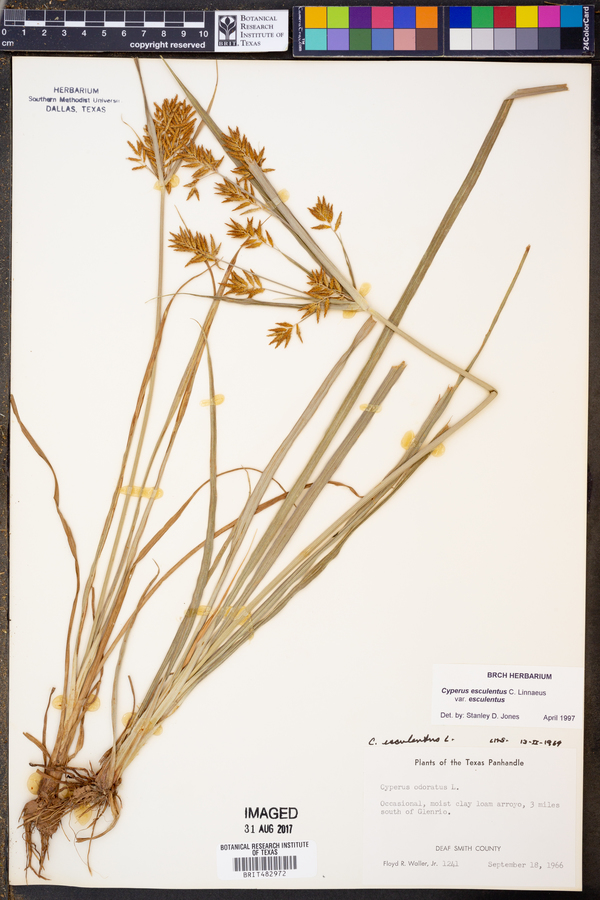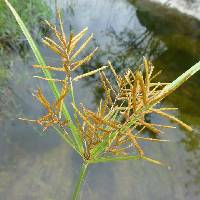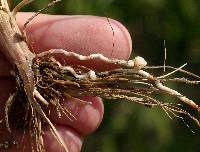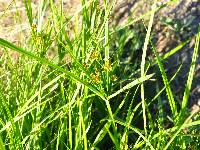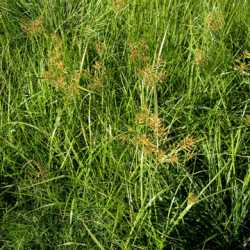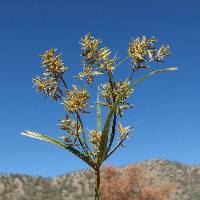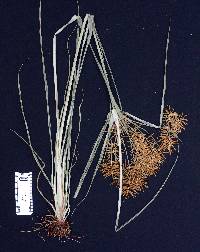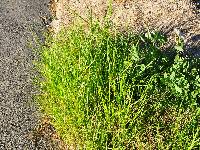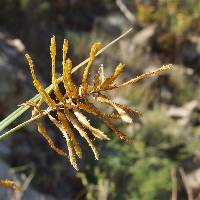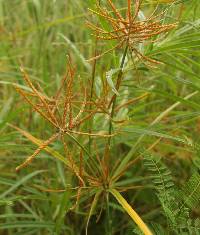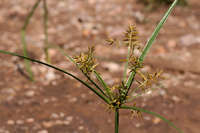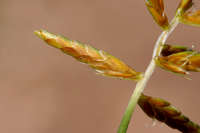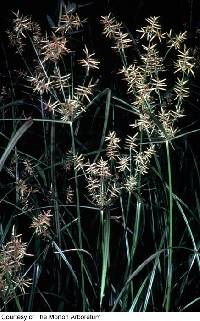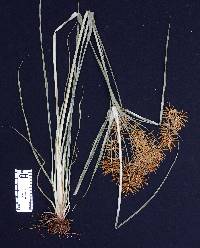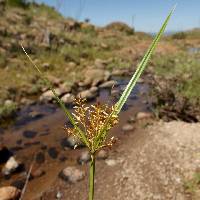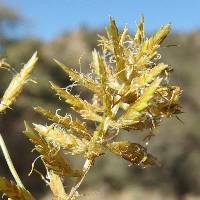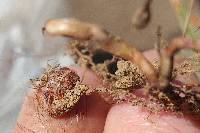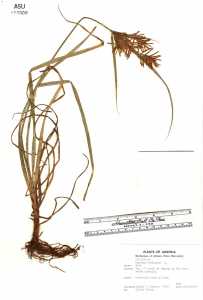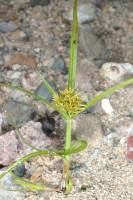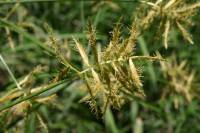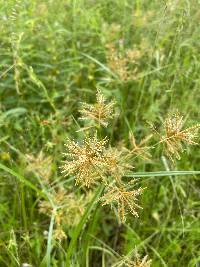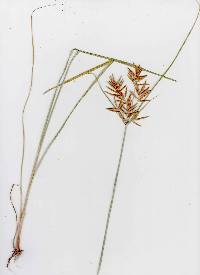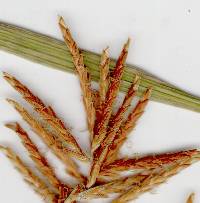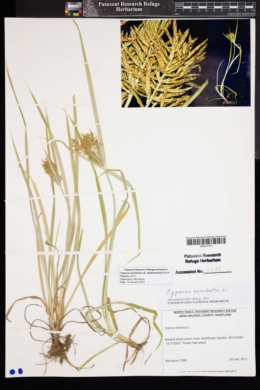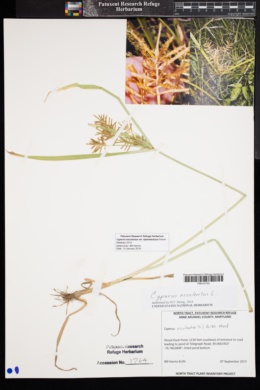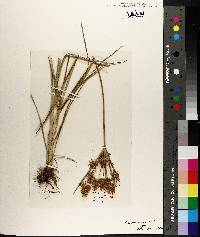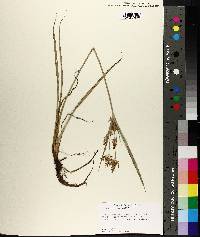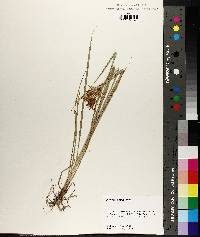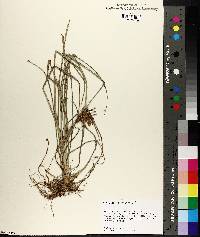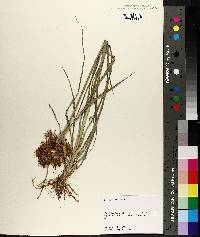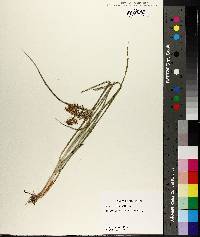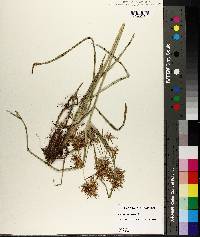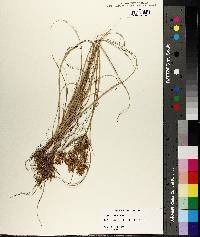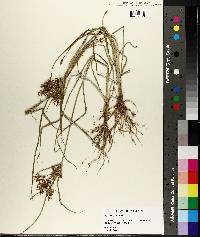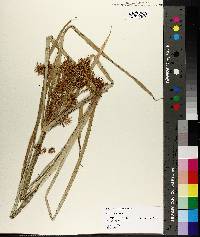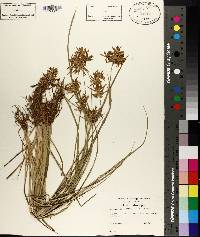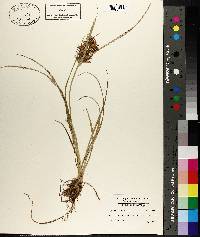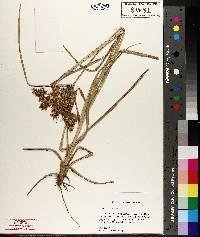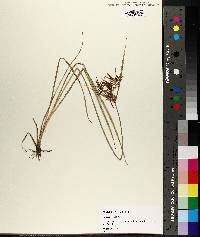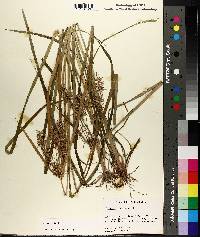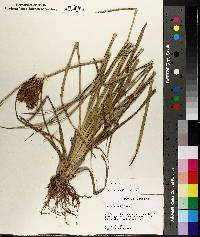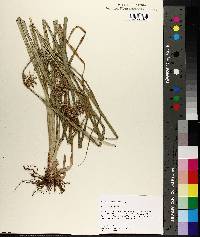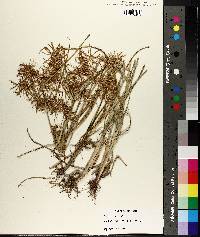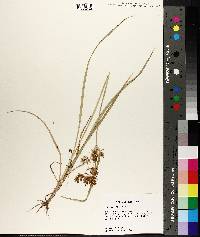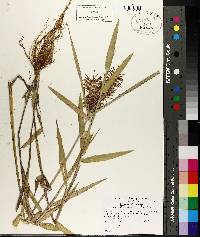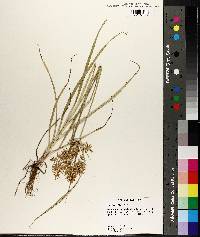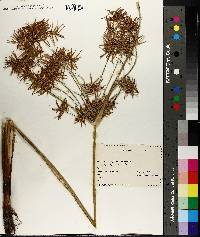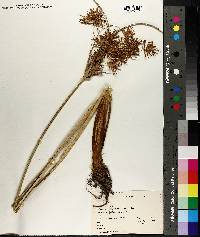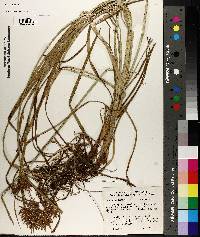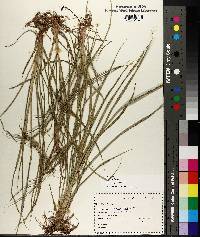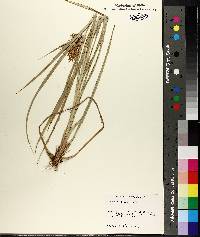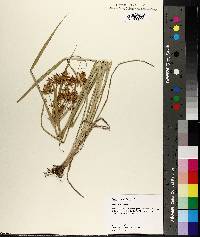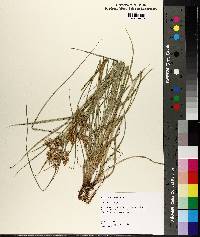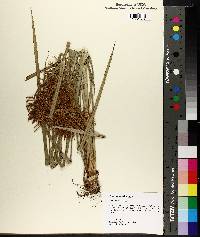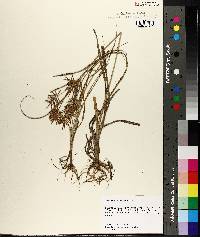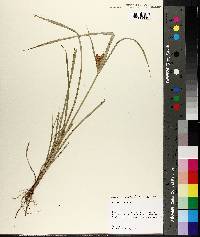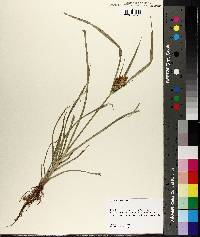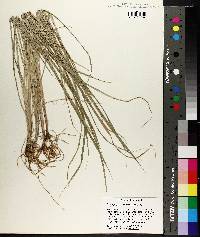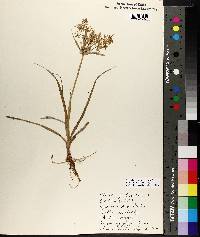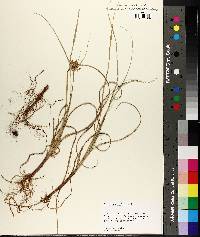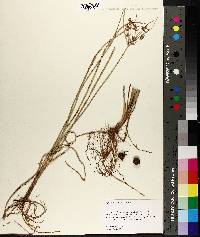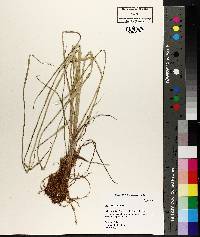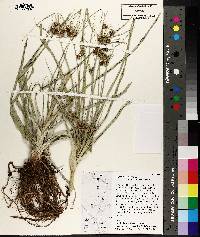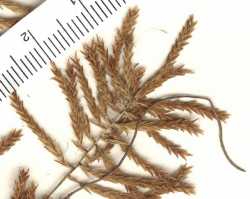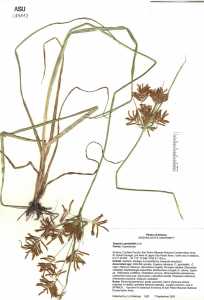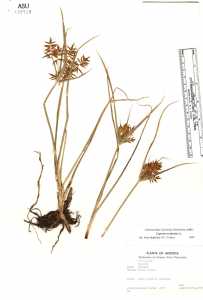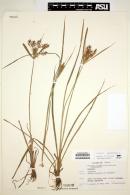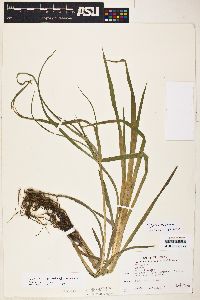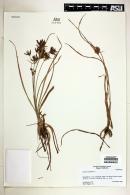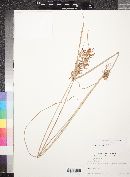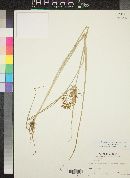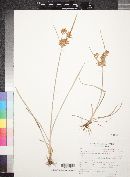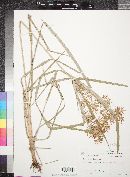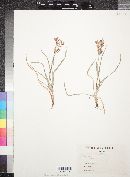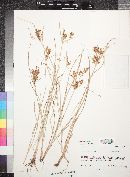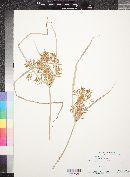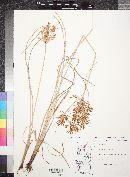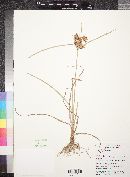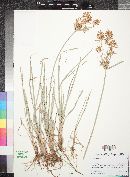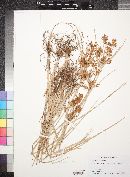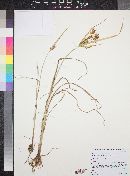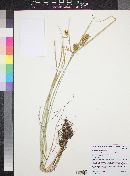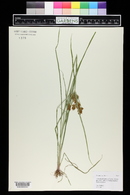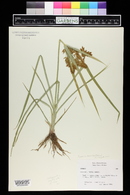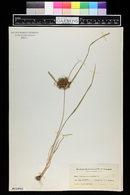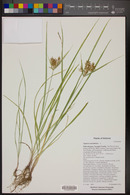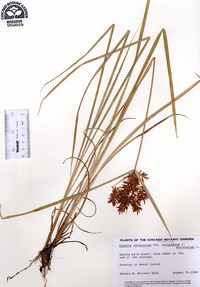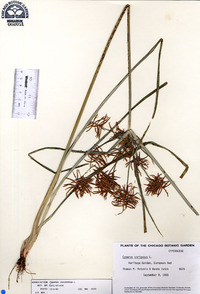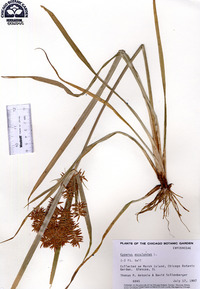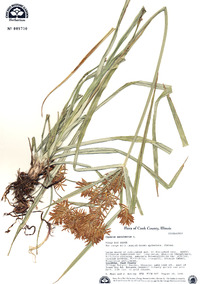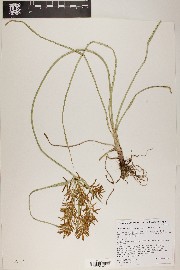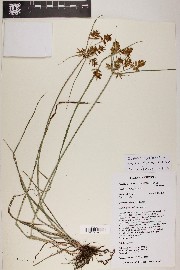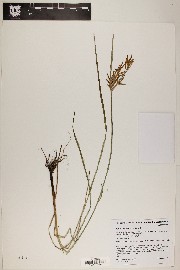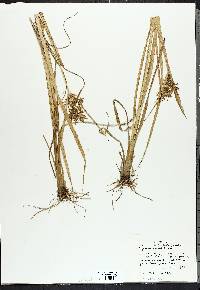Cyperus esculentus
|
|
|
|
Family: Cyperaceae
Chufa, more...yellow nutsedge, chufa flatsedge, yellow nutgrass (es: coquito, tulillo, peonía)
[Cyperus esculentus f. angustispicatus (Britton) Fernald, moreCyperus esculentus f. macrostachyus (Boeckeler) Fernald, Cyperus esculentus var. phymatodes (Muhl.) Kük., Cyperus heermannii Buckley, Cyperus phymatodes , Cyperus repens Elliott] |
Herbs, perennial, stoloniferous; stolons soft, spongy, flexible when dried, 2-8(-15) cm, bearing tubers (3-)6-11 mm diam. Culms trigonous, 15-60 (-100) cm × 0.6-3.4 mm, glabrous. Leaves 3-7, flat to V-shaped or flanged V-shaped, (6-)20-40(-80) cm × 2-4 (-6.5) mm. Inflorescences: spikes broadly ellipsoid to ovoid or hemispheric, (12-)18-30 × (12-)18-35 mm; rachis 4-17 mm; rays 4-10, (0.3-)2-12 cm; bracts (3-)4-5(-7), ± horizontal to ascending at 45(-75)°, V-shaped to flanged V-shaped, (1.5-)5-30 cm × 0.5-4 mm; rachilla persistent, wings hyaline, 0.3-0.5 mm wide. Spikelets (3-)10-20(-28), divaricate or ascending, yellowish brown to dark brown, linear to linear-lanceoloid, compressed-quadrangular, (5-)10-20(-55) × (1.2-)1.4-2(-3) mm; floral scales persistent, 6-34, spreading or appressed, ovate-lanceolate, laterally 7-9-ribbed, laterally yellowish brown to dark brown medially brownish, reddish, or greenish, ovate, or ovate-deltate, medially 3-ribbed, 1.8-2.7(-3.4) × (1-)1.5-1.8(-2.4) mm, apex acute or sub-acute. Flowers: anthers (1-)1.2-1.5(-2.1) mm; styles (0.7-)1-1.2(-2.2) mm; stigmas (1.2-)1.8-2.3(-4) mm. Achenes (seldom maturing) brown, sessile, ellipsoid, (1.1-)1.3-1.5(-1.6) × 0.3-0.6(-0.8) mm, apex obtuse, surfaces puncticulate. Cyperus esculentus is a widespread and polymorphic species. Although seven varieties have been recognized (G. Kükenthal (1935-1936), recent studies based primarily on spikelet features provided support for four varieties (P. Schippers et al. 1995). Cyperus esculentus var. esculentus is restricted to the Old World.
Perennial herb with slender rhizomes and runners 10 cm - 0.7 m tall Leaves: three to seven, basal, alternate, 20 - 40 cm long, 2 - 8 mm wide, flat or V-shaped in cross-section, linear, parallel-veined, keeled beneath, with a sheathing base that encloses the stem. Inflorescence: consisting of terminal spikes, subtended by spirally arranged leafy bracts. Bracts four to five, more or less horizontal to ascending, unequal, 5 - 30 cm long, 0.5 - 4 mm wide, V-shaped in cross-section. Rays (branches of inflorescence) four to ten, to 12 cm long. Spikes 1.5 - 3 cm long, 1.5 - 3.5 cm long, broadly ellipsoid to egg-shaped or hemispheric, consisting of ten to twenty spikelets. Flowers: minute, in the axil of a floral scale, lacking sepals and petals. Stamens exserted. Anthers 1 - 2 mm long. Pistil one. Style to 2 mm long. Stigma to over 2.5 mm long. Fruit: a one-seeded achene, stalkless, brown, about 1.5 mm long and 0.5 mm wide, oblong with a rounded apex, unequally three-angled, tiny-dotted, often not maturing. Seed with a thin, non-adherent wall. Culm: stout, 10 cm - 0.7 m long, 0.5 - 3.5 mm wide, triangular in cross-section, solid. Spikelets: wide diverging or ascending, 1 - 4 cm long, 1.5 - 3 mm wide, linear to linear lance-shaped, compressed four-angled, subtended by two small bracts, with six to thirty-four floral scales. Scales appressed or spreading, brownish or reddish or greenish down the middle, yellowish brown to dark brown along the sides, 2 - 3.5 mm long, 2 - 2.5 mm wide, egg- lance-shaped with a more or less pointed apex, seven- to nine-ribbed, lowest one empty. Similar species: No information at this time. Flowering: mid-July to early August Habitat and ecology: Frequent in moist, fertile soil, often in cultivated areas. Occurence in the Chicago region: native Etymology: Cyperus is the ancient Greek word for sedge. Esculentus means edible. Author: The Morton Arboretum FNA 2002, Allred and Ivey 2012, Rink and Licher in prep (draft for Flora Neomexicana IV) Common Name: yellow nutsedge Duration: Perennial Nativity: Native Lifeform: Graminoid General: Stout herbaceous perennial graminoid, 10-70 cm tall, with stems arising singly from slender rhizomes; stems sharply three edged; rhizomes have small tubers at the tips; herbage sweet-scented. Vegetative: Leaves clustered at base of stem; blades elongate and grass-like, 3-8 mm wide; inflorescence is subtended by a whorl of leaf-like bracts, these elongate, unequal in length, and sometimes wider than the true leaves at the base of the plant. Inflorescence: Spikelets borne in open (seldom short and congested), cylindric spikes with more or less elongate rachis, the terminal spike or cluster of spikes sessile, others borne singly or in small groups at the ends of rays up to 7 cm long; spikes slender, 0.5-5 cm long, 2-3 mm wide; scales subtending each flower mostly 3 mm long, several-nerved, broad and much overlapping laterally, but not closely set, with the tip of each scale surpassing the next by 1-2 mm; rachilla narrowly hyaline-winged, persistent. Ecology: Found on moist, low ground along streams and ditches, from 4,000-8,000 ft (1219-2438 m); flowers August-September. Distribution: Cosmopolitan, introduced throughout the world; throughout N. Amer. in every state in the US except MT and WY; south through MEX to S. Amer. Notes: Distinguished by being an erect perennial nutsedge from thin, inconspicuous rhizomes; resmbles C. odoratus but is distinguished by the spikelets which are generally wider, greater than 1.5 mm wide, and which break off at the base, leaving the naked winged inflorescence branch (rachilla) behind on the plant. C. odoratus is an annual with generally narrower spikelets, about 1 mm wide, with inflorescence branches (rachillas) that split apart between the spikelets, so that each spikelet takes a small section of rachilla with it and there are no naked rachillas left on the plant. C. esculentus has 3 varieties in North America, but these may not be worth distinguishing because the speciemens, at least those in New Mexio, exhibit continuous variation in the distinguishing traits. Ethnobotany: The tubers were eaten raw, and also baked or boiled like potatoes; used as a ceremonial emetic; the roots were chewed for coughs and colds. Etymology: Cyperus is from the Greek word meaning sedge; esculentus means edible. Synonyms: Cyperus phymatodes Editor: SBuckley 2010, FSCoburn 2015, AHazelton 2017 Sweet-scented perennial with numerous slender rhizomes ending in small tubers; stems stout, triquetrous, 1-7 dm, smooth; lvs basally disposed, elongate, 3-8 mm wide; at least the lower invol bracts surpassing the infl; rays usually several, to 7 cm but more often not surpassing the sessile spikes, often again branched at the top; prophyll obliquely truncate or prolonged 1-3 mm beyond the orifice; spikes numerous in short-cylindric spikes, slender, 0.5-5 cm, only 1-2 mm wide, with 8-30+ fls; scales yellow-brown, (2-)2.5-3(-3.5) mm, thin, scarcely keeled, ovate, acute, conspicuously 7-9-nerved; rachilla persistent, narrowly hyaline-winged; achenes oblong, unequally
trigonous, 1.3-2 mm, tan to golden-brown; 2n=108. Damp or wet soil, sometimes a weed; widespread in trop. and temp. (but not cold-temp.) regions, and nearly throughout our range. Gleason, Henry A. & Cronquist, Arthur J. 1991. Manual of vascular plants of northeastern United States and adjacent Canada. lxxv + 910 pp. ©The New York Botanical Garden. All rights reserved. Used by permission. |
|
|
|

